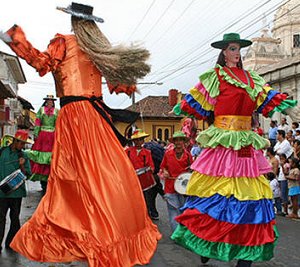- Vlog 48-This SMALL TOWN in Matagalpa has BEAUTIFUL HOUSES!Posted 1 year ago
- Vlog 47-Driving TOUR in the North City of Nicaragua “ESTELI”Posted 1 year ago
- Vlog 46- Leon during Holy Week A GREAT TIME TO VISIT!Posted 1 year ago
- Vlog 45- Moving to Nicaragua – How to Relocate SuccessfullyPosted 1 year ago
- Vlog 44-Fireworks in Leon NicaraguaPosted 1 year ago
- Vlog 43- Is it true Why No Rental Properties in Poneloya & Las Penitas NicaraguaPosted 1 year ago
- Vlog 42-This is the TRAFFIC at NIGHT in Esteli, Nicaragua.Posted 1 year ago
- Vlog 41- Cultural SHOCK in Reverse Trip to the USA from NicaraguaPosted 1 year ago
- Vlog 40-Is U.S Real Estate Market impacting Nicaragua?Posted 1 year ago
- Vlog 38- Why choosing an expensive area in Nicaragua can be a mistakePosted 1 year ago
La Gigantona

Especially on Calzada street in Granada you will see the popular “La Gigantona”. Tourists enjoy the street act though it gets old pretty fast because they play the drums too loud. Depending on how well they do the street act it can be a very colorful street play. With the dancing Gigantona are drums, sometimes popular folk verses and dancing accompaniment. It was first created by Nicaraguan mestizos (a mix of Spanish people and natives). There are usually four characters in this street act: La Gigantona, El Enano Cabezon, El Coplero and El Tamborilero.
La Gigantona is like a big doll which can be up to three meters tall constructed on a wood frame. She usually wears a colorful dress and may have many ornamentations and jewelry. La Gigantona represents the tall white Spanish woman that came with the conquistadors. El Enano Cabezon is a small dwarfish figure with a big head symbolizing the intelligent mestizo. El Coplero is the person who recites the popular folk verses and the Tamborilero is the one who plays the drum. The La Gigantona and El Enano Cabezon both dance to the rhythm of the drums. You can see this street act on the colonial streets of Granada and Leon. They even have a special competition that takes place each December 8th at the Central Plaza in Leon where local judges choose the best ornamented and most beautiful “Gigantona”.
The Indians first carved the Gigantona in a burlesque form, that despite its beauty, its height and its very whiteness, the Indians make it dance to the drums and stop when the Coplero tells it to. This allows the Indian to feel superior to the Spanish since they control the dance. The Indian was portrayed in El Enano Cabezon being small in stature but with a big brain . December is the month of the most pure and cities that still preserve the old ways with its sunset lit cloudscapes and streaked with violet leaden horizon , announcing the departure of Gigantona. The legendary lady appears, brimming with freshness and color, always adorned with her golden jewels, the hollow drums and in the dim light of the stars, the Gigantona dances with her colorful costumes of resplendent colors or a golden crown, but always has her long hair .
The Gigantona was certainly prior to the cobbled streets and dusty colonial towns . The first appearances of Gigantona are lost in the mists of time. The Gigantona is like a mysterious apparition and has become part of the Nicaraguan legends. She has survived the assault of electric lighting, the pavement of the streets and the various expressions of progress.
El Enano Cabezon is part of the group accompanying the haughty and beautiful Gigantona. He represents the Indian or mestizo which was subjected to the created and imposed superiority of the Spanish colonists. The relationship between Gigantona and the dwarf reflects the emerging and later bitter struggle between social classes. Through the spoken verses the dwarf shows its great love that this beautiful Spanish woman has awakened in him and that she is unable to reciprocate. Furthermore, the balladeer (El Coplero) recites his frustration at receiving rejection from the unattainable white goddess white. The dwarf represents the small statured Indian and its large head represents how intelligent the Nicaraguan men were like many who have made history in the world : Ruben Dario , Jose de la Cruz Mena, Alfonso Cortés and others.

Pingback: Visiting Nicaragua: The Good, The Bad, and the Ugly
Pingback: León, Nicaragua - 42Strong.com